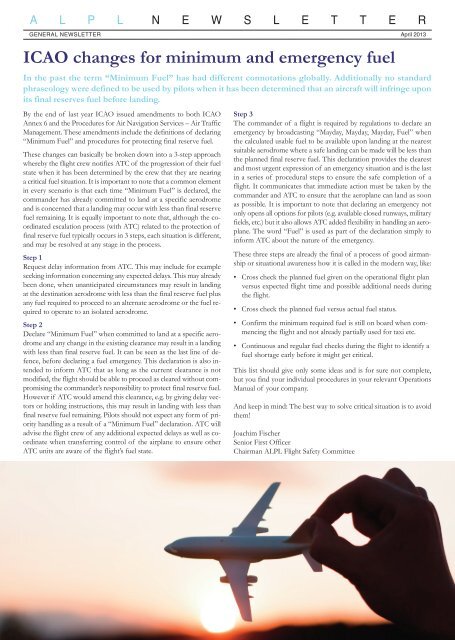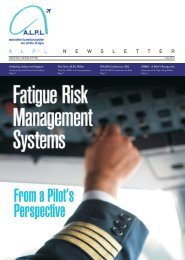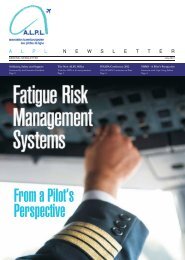Create successful ePaper yourself
Turn your PDF publications into a flip-book with our unique Google optimized e-Paper software.
A L P L N E W S L E T T E R<br />
GENERAL NEWSLETTER April 2013<br />
<strong>ICAO</strong> <strong>changes</strong> <strong>for</strong> <strong>minimum</strong> <strong>and</strong> <strong>emergency</strong> <strong>fuel</strong><br />
In the past the term “Minimum Fuel” has had different connotations globally. Additionally no st<strong>and</strong>ard<br />
phraseology were defined to be used by pilots when it has been determined that an aircraft will infringe upon<br />
its final reserves <strong>fuel</strong> be<strong>for</strong>e l<strong>and</strong>ing.<br />
By the end of last year <strong>ICAO</strong> issued amendments to both <strong>ICAO</strong><br />
Annex 6 <strong>and</strong> the Procedures <strong>for</strong> Air Navigation Services – Air Traffic<br />
Management. These amendments include the definitions of declaring<br />
“Minimum Fuel” <strong>and</strong> procedures <strong>for</strong> protecting final reserve <strong>fuel</strong>.<br />
These <strong>changes</strong> can basically be broken down into a 3-step approach<br />
whereby the flight crew notifies ATC of the progression of their <strong>fuel</strong><br />
state when it has been determined by the crew that they are nearing<br />
a critical <strong>fuel</strong> situation. It is important to note that a common element<br />
in every scenario is that each time “Minimum Fuel” is declared, the<br />
comm<strong>and</strong>er has already committed to l<strong>and</strong> at a specific aerodrome<br />
<strong>and</strong> is concerned that a l<strong>and</strong>ing may occur with less than final reserve<br />
<strong>fuel</strong> remaining. It is equally important to note that, although the coordinated<br />
escalation process (with ATC) related to the protection of<br />
final reserve <strong>fuel</strong> typically occurs in 3 steps, each situation is different,<br />
<strong>and</strong> may be resolved at any stage in the process.<br />
Step 1<br />
Request delay in<strong>for</strong>mation from ATC. This may include <strong>for</strong> example<br />
seeking in<strong>for</strong>mation concerning any expected delays. This may already<br />
been done, when unanticipated circumstances may result in l<strong>and</strong>ing<br />
at the destination aerodrome with less than the final reserve <strong>fuel</strong> plus<br />
any <strong>fuel</strong> required to proceed to an alternate aerodrome or the <strong>fuel</strong> required<br />
to operate to an isolated aerodrome.<br />
Step 2<br />
Declare “Minimum Fuel” when committed to l<strong>and</strong> at a specific aerodrome<br />
<strong>and</strong> any change in the existing clearance may result in a l<strong>and</strong>ing<br />
with less than final reserve <strong>fuel</strong>. It can be seen as the last line of defence,<br />
be<strong>for</strong>e declaring a <strong>fuel</strong> <strong>emergency</strong>. This declaration is also intended<br />
to in<strong>for</strong>m ATC that as long as the current clearance is not<br />
modified, the flight should be able to proceed as cleared without compromising<br />
the comm<strong>and</strong>er’s responsibility to protect final reserve <strong>fuel</strong>.<br />
However if ATC would amend this clearance, e.g. by giving delay vectors<br />
or holding instructions, this may result in l<strong>and</strong>ing with less than<br />
final reserve <strong>fuel</strong> remaining. Pilots should not expect any <strong>for</strong>m of priority<br />
h<strong>and</strong>ling as a result of a “Minimum Fuel” declaration. ATC will<br />
advise the flight crew of any additional expected delays as well as coordinate<br />
when transferring control of the airplane to ensure other<br />
ATC units are aware of the flight’s <strong>fuel</strong> state.<br />
Step 3<br />
The comm<strong>and</strong>er of a flight is required by regulations to declare an<br />
<strong>emergency</strong> by broadcasting “Mayday, Mayday, Mayday, Fuel” when<br />
the calculated usable <strong>fuel</strong> to be available upon l<strong>and</strong>ing at the nearest<br />
suitable aerodrome where a safe l<strong>and</strong>ing can be made will be less than<br />
the planned final reserve <strong>fuel</strong>. This declaration provides the clearest<br />
<strong>and</strong> most urgent expression of an <strong>emergency</strong> situation <strong>and</strong> is the last<br />
in a series of procedural steps to ensure the safe completion of a<br />
flight. It communicates that immediate action must be taken by the<br />
comm<strong>and</strong>er <strong>and</strong> ATC to ensure that the aeroplane can l<strong>and</strong> as soon<br />
as possible. It is important to note that declaring an <strong>emergency</strong> not<br />
only opens all options <strong>for</strong> pilots (e.g. available closed runways, military<br />
fields, etc.) but it also allows ATC added flexibility in h<strong>and</strong>ling an aeroplane.<br />
The word “Fuel” is used as part of the declaration simply to<br />
in<strong>for</strong>m ATC about the nature of the <strong>emergency</strong>.<br />
These three steps are already the final of a process of good airmanship<br />
or situational awareness how it is called in the modern way, like:<br />
• Cross check the planned <strong>fuel</strong> given on the operational flight plan<br />
versus expected flight time <strong>and</strong> possible additional needs during<br />
the flight.<br />
•<br />
•<br />
•<br />
Cross check the planned <strong>fuel</strong> versus actual <strong>fuel</strong> status.<br />
Confirm the <strong>minimum</strong> required <strong>fuel</strong> is still on board when commencing<br />
the flight <strong>and</strong> not already partially used <strong>for</strong> taxi etc.<br />
Continuous <strong>and</strong> regular <strong>fuel</strong> checks during the flight to identify a<br />
<strong>fuel</strong> shortage early be<strong>for</strong>e it might get critical.<br />
This list should give only some ideas <strong>and</strong> is <strong>for</strong> sure not complete,<br />
but you find your individual procedures in your relevant Operations<br />
Manual of your company.<br />
And keep in mind: The best way to solve critical situation is to avoid<br />
them!<br />
Joachim Fischer<br />
Senior First Officer<br />
Chairman ALPL Flight Safety Committee




